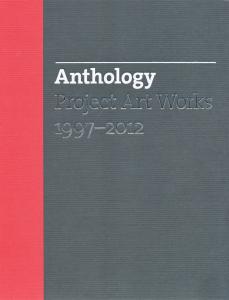Maggie Hampton finds immensely vibrant and powerful art in Project Art Works Anthology.

Project Art Works is an organisation based in East Sussex which uses the visual arts to create innovative collaborations involving artists, people who have profound intellectual impairment and those that support them, and this Anthology is a look back over 15 years of their work. I would have liked to see the anthology with a creative name, keeping ‘Anthology Project Art Works 1997-2012’ as the strap-line. I felt that the factual title flagged the book up as a record to be read and filed rather than a platform for the creativity of people with intellectual impairment.
The Anthology includes high quality images from a range of collaborative projects. We see artists, disabled and non-disabled, working together using paint, video and sculpture. The images are beautifully presented in the book. I especially liked the ‘Polaroids’ chapter, showing a wide range of Polaroids taken by participants, artists and collaborators and I really loved the chapter ‘A Selection from the Archive’ where each image was given its own page, the opposite being blank with just the artist’s name. It was very good to see the work of learning disabled people given such respect and dignity, not agitated by explanations or anything academic or medical.
Other sections of the anthology include five essays, quite academic in tone; for example one is ‘Social care: shifts, changes and impact on people with complex needs’. Of course, all of the essays related to the arts and people with intellectual impairments, but I felt somewhat uncomfortable with them. That sense of disabled people being under the microscope does not sit very easily alongside the power of the art and the artist. Disabled people have been medicalised for so long, contributing to an ‘us and them’, disabled people seen as the victims or ‘other’, and the essays felt like a nudge in that direction.
In recent decades there has been a long struggle towards empowerment and a more equal society, and the arts have played a major role in redressing some of the imbalance, putting things from our unique perspective. I know that people with profound intellectual impairments can not participate in a political movement or an arts movement in the same way as people with other impairments. However, the art works in the anthology are immensely vibrant and powerful, and I feel that they would stand alone even more strongly without the support of essays, no matter how explanatory or educating.
In terms of explanations of the process, what worked well for me was the more creative text. ‘Insideout Art’ was blank verse by Andrew Kotting, where he describes working with his daughter Eden:
This is new territory.
The place rumbles with relationships.
A locus and conglomeration for incongruous
thoughts and outcomes.
It is alive with happenings
I also liked the collaborating artists’ descriptions of the process. Sarah Broome describes working with Clare Maynard:
You reach up with your brush, catching some of the light – and paint a brief stroke. You glance at Tim’s marks and bring your brush over to tap seven times on the dripping paint.
The blank verse and creative prose really complements the artworks in the book and I would have liked to see more. Certainly, anyone interested in working in the arts with people with intellectual impairments should read this anthology; it is a really good introduction to an area of work that many people know nothing about. I will certainly be looking out for Project Art Works from now on.
Maggie Hampton is Strategic Director of Disability Arts Cymru. Disability Arts Cymru works across Wales promoting equality in the arts for disabled people.
www.disabilityartscymru.co.uk
www.projectartworks.org/publications



